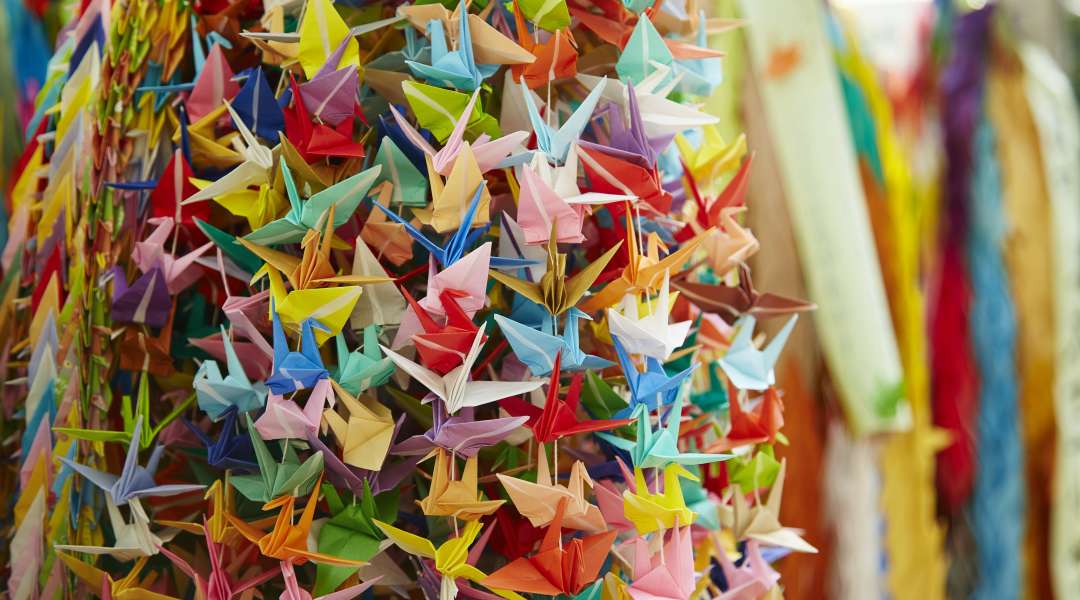
Whether it’s cranes, elephants, swans or flowers, the Japanese practice of origami (折り紙, literally ‘fold paper’) has the capacity to take something as ordinary as paper and make it into something extraordinarily beautiful. Flourishing in the 1600s during Japan’s Edo period (when the country was shut off to the majority of the outside world), origami as we know it today played a role in both keeping people entertained with simple tools and helping bring court ceremonies and rituals to life with fantastic displays of art.
It has now evolved into a worldwide phenomenon, strongly associated with Japanese culture, and plays a strong symbolic role in places like Hiroshima. Traditionally, it is thought that if you were to fold 1000 paper cranes - a sacred animal believed to live for 1000 years - you would be granted a wish, or bestowed with health and good fortune. Nowadays, you can experience origami in person at the Hiroshima Peace Memorial through the moving story of one young girl’s wish for world peace in the aftermath of war, or at the Origami Kaikan in Tokyo which offers classes to visitors.
But the beauty of origami is also in its simplicity, making it an easy and rewarding way to while away hours spent at home. So without further ado, let’s get stuck in with some basics on where to start and some simple but fun patterns.
PAPER PAPER PAPER
Origami has become such a big deal that the master folders and die hard fans have created a whole separate industry around delicately patterned paper perfect for the pro-level folds. But that doesn’t mean you can't make use of what you have at home for some origami magic.
You’re going to have to start with a square-shaped piece of paper, so grab any old piece of A4 (spam through the letterbox, old pictures of you and your ex, an unpaid bill etc), turn it so one of the long edges is facing you, place your left finger on the top left corner, and use your right hand to bring the bottom right corner up to meet the long edge of the paper facing away from you. This should leave you with a folded triangle on the left and an upright rectangle on the right. Make a fold where the triangle meets the rectangle and either cut along that fold or apply pressure and run your nail along it whilst it's folded, and tear.
If in doubt, let Andy Origami show you how!
Cherry Blossom
Now you have your paper, warm up your finger ligaments and get folding.
World events have meant that enjoying the explosion of pinks and reds that comes with cherry blossom season has been extra difficult for people inside Japan and outside Japan. But who needs to leave the house, right..? Try this simple folding pattern and make your own Sakura cherry blossoms and bring the outside in, while joining Japan in celebrating one of the calendar’s most long awaited events.
Spoilers: some small scissor work required (it’s not cheating, we swear!).
Koi Carp
In Japan, animals hold immense traditional significance, and just like the crane signifies longevity, the koi carp signifies bravery, strength and determination for how skilled they are at swimming upstream, against the current, and even climbing waterfalls. This pattern teaches you how to make ‘Koinobori’ (鯉のぼり) aka carp streamers or windsocks, which are traditionally flown on Children’s Day in Japan in May, to wish courage and success for children across the country.
There are some sticks, string and tape involved in making the streamers, but if you’d rather stick to the folding, you’ll also learn how to easily fold yourself a koi carp. Try it yourself and don't worry, there's plenty of verbal instructions to boot.
Samurai Helmet
Maybe the most iconic of all - the symbol of bravery and honour in feudal Japan - the Samurai. Visitors to Japan can still get themselves a slice of the samurai pie in historic places like Aizuwakamatsu, with its samurai training academies and kendo sword schools, or Kanazawa, with its well preserved Samurai houses, but this pattern from the Japan Society will talk you through how to fashion your very own ‘kabuto’ samurai helmet using only folds. Many fun phrases come from the word ‘kabuto’ in Japanese (like 'kabuto o nugu', or, to take off your kabuto, meaning to give up or give in) and it is also the name given to horn beetles or rhinoceros beetles given the resemblance of their armour.
Aside from doubling as a tiny fashion-forward head piece, this Kabuto can also be used as a handy bookmark! Try pushing your origami limits by making one yourself!
Sharing your creations with the world
If you really take a shine to it, visit the British Origami Society’s website for more info. They’re currently encouraging people to make origami hearts and share them on social media in recognition of the efforts of NHS workers in the UK during the COVID-19 pandemic; you can check them out here. And in old school Blue Peter fashion, here are some we made earlier!

And if you’re still craving more, keep an eye on our Facebook and Instagram in the following weeks as we step up our game and try our hands at some more complicated patterns (especially if the words ‘Ghibli’ and ‘Pokemon’ mean anything to you...)
To stay up to date with all the latest happenings in Japan follow us on Facebook or Twitter.


























































